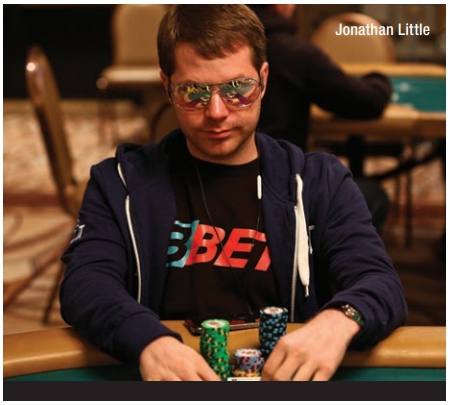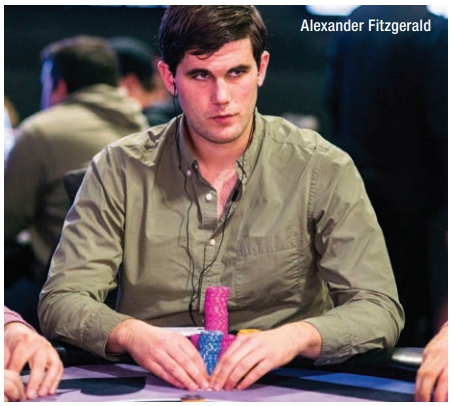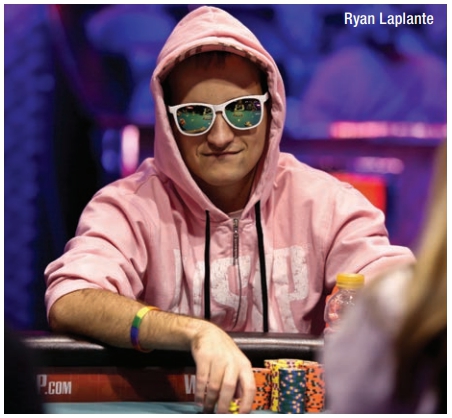






Head Games: Proper Bet Sizing With Premium Pocket Pairsby Craig Tapscott | Published: Jan 27, 2021 |
|
|

The Pros: Alex Fitzgerald, Jonathan Little, and Ryan Laplante
Craig Tapscott: When you have a big hand preflop (aces, kings, or queens) in late position and a player has already opened UTG+1 at a full table, what are the variables that determine what your bet sizing will be when and if you raise?
Alex Fitzgerald: If I’ve got an extremely loose player behind me who is calling down big bets with any pair, then I’ll definitely consider calling preflop. If that loose recreational player is in the big blind, then I’m even more inclined to smooth call. They will likely call with close to anything while in the big blind and getting a discount. While multi-way pots are messier, I’d prefer a multi-way pot with one guy who will pay off with any pair as opposed to a slightly bigger heads-up pot with one great player. If the initial opener is fantastic post-flop, he’s probably not going to give me a ton of money anyway if I three-bet him, so that is also a time I will consider flatting.
That said, the vast majority of the time I will three-bet. I find Americans love to call three-bets out of position with anything they opened, so I love taking advantage of that. You want them to put as much money in the middle as possible, obviously. The art form is figuring out who can’t fold preflop. Typically, people who are always limping, cold calling, raising, and trying to see flops are the types of people who get really touchy when you try to deny them a flop they want to see. You might know 4-6 suited is a fold, but they don’t. They really want to see that flop with their high VPIP (Voluntarily Put $ in Pot). So, in that case, you can even pump it to 3.5 times their opening bet, because they’ll still call you. With regs who are comfortable folding preflop, you can shade the bet down a little smaller.
 Jonathan Little: The main concerns when you have a hand you want to potentially three-bet are the initial raiser’s range, and the stack depths. As stacks get shorter, there is usually some merit to calling with aces, and perhaps kings, because you really want to get value from those hands, and calling allows you to call with a slightly wider range of hands that flop well, like 9-8 suited.
Jonathan Little: The main concerns when you have a hand you want to potentially three-bet are the initial raiser’s range, and the stack depths. As stacks get shorter, there is usually some merit to calling with aces, and perhaps kings, because you really want to get value from those hands, and calling allows you to call with a slightly wider range of hands that flop well, like 9-8 suited.
As stacks get deeper though, you should almost always three-bet with your best hands because you want to build the pot and extract value. You typically want to three-bet to about 2.5 times the initial raise when you are in position and to about 3.5 times when you are out of position. If someone raises to 500 and you are in position, make it 1,250. If you are out of position, make it 1,750. As stacks get really deep, perhaps 100 big blinds or more, you can instead three-bet to 3x in position and 4x out of position.
Ryan Laplante: When playing a tournament, you will generally be between 40-80 big blinds deep in this type of situation. When considering what to three-bet, and the size, we need to think about three main factors.
What is their opening range, how deep are the effective stacks, and are we in position or out of position? Let’s say we are 60 big blinds deep, and we are up against an early position raise. So, their range should be somewhat tight (8-18% of top tier hands depending on the player). Because of that and how deep we are, we need to make our three-bet size somewhat large.
A general rule of thumb to follow against a single raise with no callers is that 2.5x equals tiny, 3x equals small, 3.5x equals medium, 4x equals large, and 5x equals very large. Where x equals their open bet size.
So in this situation, I would three-bet to 3.5x or 4x their opening bet and do so with a range of 10-10+/A-Q+ for the most part and might mix in some bluffs like A-5 suited, K-9 suited, or J-9 suited. Now, if we were in the small blind or big blind I would three-bet to 4.5×. So, if they opened to 2,000, and we were in cutoff I’d three-bet to 7,000, while if we were in the small blind, I’d three-bet to 9,000 or even 10,000.
Craig Tapscott: Please breakdown your thoughts on how you determine bet sizing on the flop with an overpair heads-up, including all various different board texture considerations. After you are called on the flop, how is your sizing on the turn or river determined versus one player that you have position on?
 Alex Fitzgerald: I tend to focus on games where I know people are playing their hand, not my hand. If I’m ever playing a player who is effectively ranging me, then I have to ask myself why I’m in that game. Because there’s always looser money out there and I’ve discovered over time that 90% of my job is game selection.
Alex Fitzgerald: I tend to focus on games where I know people are playing their hand, not my hand. If I’m ever playing a player who is effectively ranging me, then I have to ask myself why I’m in that game. Because there’s always looser money out there and I’ve discovered over time that 90% of my job is game selection.
In the games I like to play, I look at the board and I ask myself what the chances are my guy has a pair. If the flop is J 9
9 7
7 , for example, that is a board where my opponent has a ton of pairs and draws with their three-bet calling range. On that kind of board, I’ll blast it, because most of the people I play with can’t raise without two pair or better. Occasionally, they’ll raise a big combination draw, but I’ll let them get away with that. It’s fairly basic what they do, as usually with a draw or pair they call, if they have better, they raise, and if they bricked, they fold. After they call, I judge the turn and river cards and go for the kill with big bets.
, for example, that is a board where my opponent has a ton of pairs and draws with their three-bet calling range. On that kind of board, I’ll blast it, because most of the people I play with can’t raise without two pair or better. Occasionally, they’ll raise a big combination draw, but I’ll let them get away with that. It’s fairly basic what they do, as usually with a draw or pair they call, if they have better, they raise, and if they bricked, they fold. After they call, I judge the turn and river cards and go for the kill with big bets.
If I know the guy can’t fold top pair and that’s his most likely holding, I’ll overbet. You trap them this way. Most guys can’t fold a pair of any kind to just one continuation bet. Most guys can’t fold a pair they liked after investing huge on that flop. If they only called a 33% pot-sized bet after you 2.2x three-bet their open, they could get away, but if you play it like this you get the bad regs and recreational players trapped. The draw misses and you bomb again. They’re not going anywhere with that much money in the middle because they feel committed. If the board comes J-5-5 however, that’s a super hit or miss board so you’re going to have to cajole them with a different bet.
Jonathan Little: On the flop, you pretty much always want to bet with your best made hands and draws. And as the board is better for your range, you should bet with an even wider range of hands including your marginal made hands and junky hands.
When you are betting less often (usually when the board is excellent for your opponent’s range or when the board is very coordinated), you should typically bet using a large size of about 75% pot. When the board is uncoordinated, you should bet more often, usually using a smaller size of about 33% pot. You should also tend to bet smaller when the board is uncoordinated but you lack the nut advantage, such as when you raise from UTG and the big blind calls on J-6-6. There, you have a big range advantage, but you completely lack the nut advantage because you have almost no trips in your range whereas your opponent has some. This should lead to you betting a tiny amount, about one big blind. After you bet the flop and get called, you should usually continue betting the turn and river with most of your best made hands and draws, again betting somewhat large due to betting somewhat infrequently.
 Ryan Laplante: Our flop continuation bet size will be based generally on how dynamic the board is. The more dynamic the board, the larger our c-bet (continuation bet) size and more frequently we might have to check back our ace highs, while the more static the board the smaller we c-bet and the more often we c-bet.
Ryan Laplante: Our flop continuation bet size will be based generally on how dynamic the board is. The more dynamic the board, the larger our c-bet (continuation bet) size and more frequently we might have to check back our ace highs, while the more static the board the smaller we c-bet and the more often we c-bet.
Static boards, like 7 6
6 5
5 , are difficult for the best hand possible to change. With dynamic boards, like Q
, are difficult for the best hand possible to change. With dynamic boards, like Q 9
9 5
5 , it’s easy for the best hand possible to change. Let’s say I had K
, it’s easy for the best hand possible to change. Let’s say I had K K
K , and we are 60,000 deep, and I had three-bet to 7,000 from the cutoff against an early position raise, and they called. The pot now is 16,500, and the stacks have 53,000 behind. On the static flop of 7
, and we are 60,000 deep, and I had three-bet to 7,000 from the cutoff against an early position raise, and they called. The pot now is 16,500, and the stacks have 53,000 behind. On the static flop of 7 6
6 5
5 , I would c-bet 25-30% of the pot, or 3,500 to 5,000. But on a dynamic Q
, I would c-bet 25-30% of the pot, or 3,500 to 5,000. But on a dynamic Q 9
9 5
5 flop, I’d c-bet 50-75% pot, or 8,000-12,000.
flop, I’d c-bet 50-75% pot, or 8,000-12,000.
What we do on the turn will be largely based on whether the turn is a good card for our range to barrel, or if it is a better card for them. On each of these boards I will be very likely to bet the turn with jacks plus, and more apt to check pocket tens down. Any time you are considering what type of decisions to make preflop you need to consider your opponent’s range, stack depths, and your position, as that will heavily dictate both bet sizes to pick and how to build your range for bluffs and for value. ♠
Alexander Fitzgerald is a former commercial fisherman and freelance writer who became a professional poker player in 2006. He writes a daily strategic poker newsletter at www.PokerHeadRush.com for real working-class people who want to learn poker. He is the author of Exploitative Play In Live Poker, as well as The Myth Of Poker Talent.
Jonathan Little is a professional poker player with more than $7 million in live tournament earnings, including two World Poker Tour titles. He is the author of 15 best-selling poker books, and the 2019 GPI Poker Personality of the Year award winner. Sign up a free account today at his training site www.PokerCoaching.com/CardPlayer.
Ryan Laplante has been a professional poker player for more than a decade and has more than $5.5 million in combined live and online tournament earnings. He has made eight WSOP final tables, and earned a bracelet by taking down the $500 buy-in PLO event in 2016. If you want to learn from him, you can do so easily and affordably through his website www.LearnProPoker.com.
Features
The Inside Straight
Strategies & Analysis
Tournament Circuit